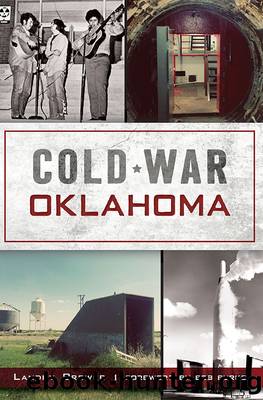Cold War Oklahoma by Landry Brewer

Author:Landry Brewer
Language: eng
Format: epub
Publisher: Arcadia Publishing Inc.
Published: 2019-01-15T00:00:00+00:00
From the May 8, 1968 Elk City Daily News. The Elk City High School civil defense support team member at the far left is eighteen-year-old Basil Weatherly. Courtesy of the author.
A 1964 SWOSU graduate, Bob Klaassen went to work for his alma mater in 1978 and retired from the university as its registrar in 2010. In a 2018 interview, Klaassen reminisced about his time occupying an office in a building where civil defense supplies were still stored in what had served as one of the campusâs fallout shelters. âI have memories of large barrels of water in the basement of the Administration Building,â Klaassen said. He also said that after the Cold War ended, the small civil defense fallout shelter signs that had adorned several campus buildings âwere removed without any fanfare.â129
The threat of an attack led to the development of the federal emergency Thunderbolt siren for civil defense in the early 1950s. The design is distinctive, as is its method of operation. Air from a pump is forced through the rotor, called the chopper, and the siren, usually mounted atop a tall pole, emits sound âat full volume throughout the chopper pitch range.â130 Elk City installed several yellow Thunderbolt sirens during the Cold War for nuclear attack warning, but the sirens were also used to warn of severe weather. Elk Cityâs Thunderbolt sirens, like the one currently mounted atop a wooden power pole behind the Elk City Fire Department, are used solely as storm sirens today, warning residents of an imminent tornado instead of an imminent nuclear missile attack.
Elk Cityâs current fire chief and emergency management director, Billy Word, joined the Elk City Fire Department in February 1989, nine months before the fall of the Berlin Wallâthe beginning of the Cold Warâs end. Today, the civil defense supplies that once stocked the fallout shelter in the Elk City Fire Department basement sit in an unassuming metal storage building at Elk City Municipal Airport. Though he cannot say with certainty, Word believes that those supplies were likely moved there in the mid-to late 1990s, after the Soviet Union disintegrated in 1991 and the Cold War ended.131 Like the removal of fallout shelter supplies and signs at SWOSU in Weatherford, the inability to pinpoint when the Elk City supplies were taken to storage speaks to the unceremonious fashion in which the Cold War ended in the United States, and yearsâ worth of planning and preparation for life-threatening nuclear attack became a distant memory for Americans, more difficult to recall with each passing day.
Download
This site does not store any files on its server. We only index and link to content provided by other sites. Please contact the content providers to delete copyright contents if any and email us, we'll remove relevant links or contents immediately.
In Cold Blood by Truman Capote(3311)
The Innovators: How a Group of Hackers, Geniuses, and Geeks Created the Digital Revolution by Walter Isaacson(2845)
Steve Jobs by Walter Isaacson(2836)
All the President's Men by Carl Bernstein & Bob Woodward(2328)
Lonely Planet New York City by Lonely Planet(2172)
And the Band Played On by Randy Shilts(2131)
The Room Where It Happened by John Bolton;(2104)
The Poisoner's Handbook by Deborah Blum(2093)
The Murder of Marilyn Monroe by Jay Margolis(2059)
The Innovators by Walter Isaacson(2056)
Lincoln by David Herbert Donald(1945)
A Colony in a Nation by Chris Hayes(1881)
Under the Banner of Heaven: A Story of Violent Faith by Jon Krakauer(1750)
Amelia Earhart by Doris L. Rich(1650)
The Unsettlers by Mark Sundeen(1647)
Being George Washington by Beck Glenn(1622)
Birdmen by Lawrence Goldstone(1621)
Dirt by Bill Buford(1612)
Zeitoun by Dave Eggers(1593)
